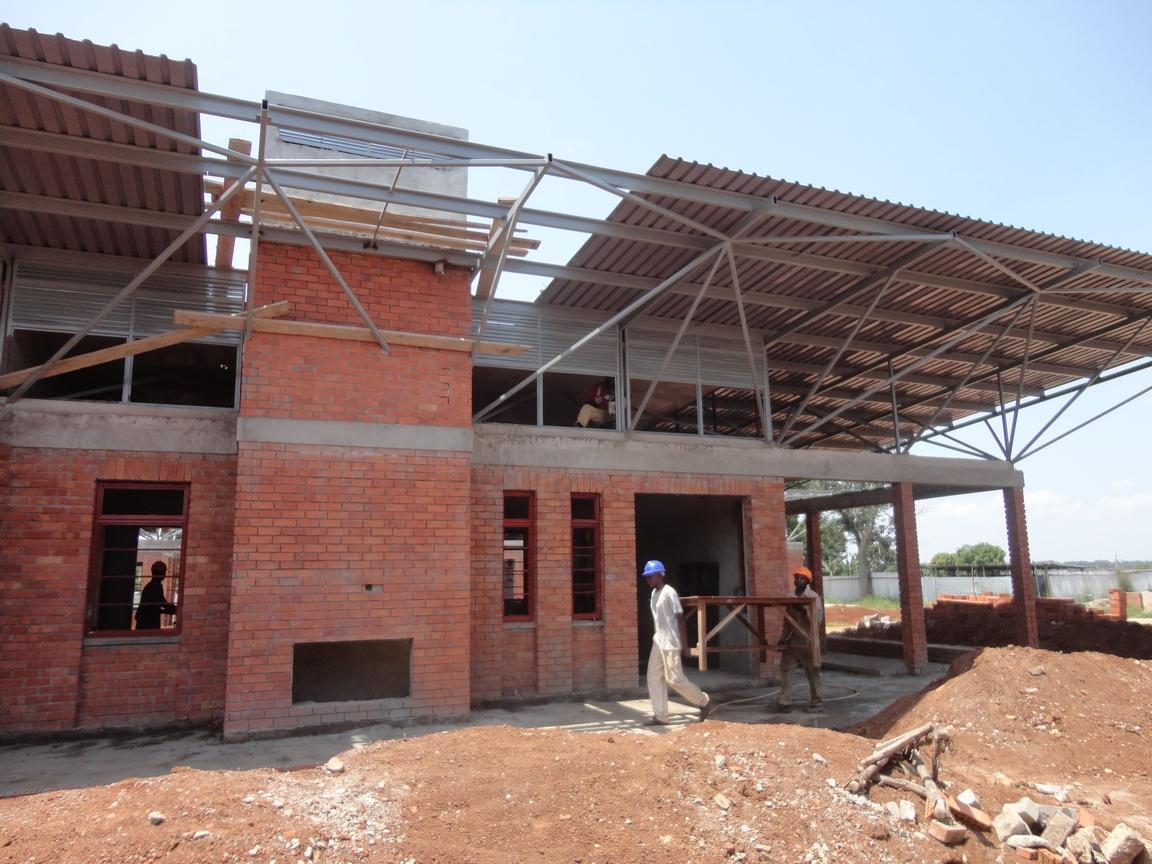Building in East-Africa: Focus on Sustainable Architecture and Energy
How can we create appropriate legislation to encourage sustainable architecture? How to educate our children and communities on this? And what if ‘sustainability’ is no longer enough? A seminar on sustainable architecture organised by the Teacher Training Education project addressed these questions on the 21st of October 2015. All with the purpose of infrastructure developments contributing towards the quality of education.
Since 2012, the Teachers Training Education (TTE) project implemented by BTC and the MoESTS supports teacher training colleges, mostly on pedagogy and management, but also on infrastructure development. This last area has a strong focus on sustainable architecture and renewable energy. All infrastructure developments emphasize, during design, execution and operation, the importance of interventions that improve conditions in the colleges and reduce operation costs.
Marten Treffers presents some of the approaches included in the project, like orientation of buildings, cross-ventilation, thermal chimneys, but also installations of biogas, solar and thermal heaters. If Ugandan architecture firms strive to acquire the same knowledge, attracting external partners would no longer be a necessity.
Key-speaker Musau Kimeu encourages all participants to advocate passionately for change: “We have to push the entire nation to work for sustainable architecture. Why? Because the benefits of sustainable architecture are great not only economically and environmentally, but also socially. For example, people who work in sustainable buildings are less sick.”
Vincent Kitio firmly agrees with this idea: “Across African cities with tropical climates, the majority of modern buildings are a replica of building designed in mostly European countries with cold and temperate climates. This results in huge energy waste.”
INCLUDING PEOPLE
Although legislation and government intervention play an
important role, the government is not the sole motor for change. Every citizen,
every user of a building, can contribute to a more sustainable architecture.
“People have a strong mind-set on how a building should be constructed,” says Nigel Tilling, “there has to be an
acceptance of technology and new materials.”
Mr. Treffers noticed that convincing partners to innovate is sometimes not an easy task: “Showcasing the use of materials and technologies, as is done during this seminar, hopefully opens many eyes.”
In our search for the perfect learning environment we need to keep the Ugandan reality in mind. As budgets are often small, low maintenance and cost efficiency are key concepts in designing schools, even more so in rural areas. That is why working with local materials such as eucalyptus is ideal.
Going for innovative techniques is definitely worthwhile in the long run. Several case studies presented show that the initial cost of investment is high but the operation costs are manageable. After a while the investment starts paying itself back. Solar panels, for instance, are long-lasting and only need battery change once a year. When those initial investments can be covered through a project like TTE, colleges can use their budget for pedagogy instead.
Schools should be encouraged to audit their use of energy. They could save more than half of their monthly electrical costs if they invest in energy saving lamps and educate staff and students on how to save energy. The colleges supported by the TTE project will reduce their firewood use by 50-70% and the electricity use will go down, on average, by 50%.
FROM SUSTAINABLE TO REGENERATIVE DESIGNS
According to Mark Olweny it has come to the point where ‘sustainability’ is not enough: “Sustainability implies something that endures without degrading, however it does not regenerate itself or create anything new. To be truly sustainable, we need to live within earth’s ecological carrying capacity.”
WHAT'S NEXT?
Throughout the entire seminar the need for a paradigm shift is expressed. But how can we achieve this? Mr. Olweny seeks the answer in value change: “Values passed on are central to enabling a sustainable and regenerative design approach. And isn’t education about changing values?”
The TTE project strongly invests in this. That is why lecturers are being trained to use new teaching methodologies and college management is being supported. The infrastructure component of the project actively chooses for innovative and sustainable building methods.
Good local examples are thus being created. But the project cannot stand on its own and will not go on forever. This seminar has shown that there is a lot of local knowhow. One challenge for the future might be to bring this fragmented knowhow together. The discussion on how different actors in the field can increase awareness and then realize more sustainable buildings must continue. Clients, for example the government or projects like TTE, must insist on adopting designs that favour energy efficiency and green architecture, and they must develop standards and guidelines for it. Architects and engineers must be innovative and recommend solutions that contribute to better conditions for the users. Professional bodies and universities must further research those interventions that are relevant for the Ugandan context. And contractors must develop their execution experience with local materials and technologies that allow sustainability.
WHO IS WHO?
Marten Treffers: Architect from the Netherlands workings as International Sector Infrastructure Expert with the TTE project.
Musau Kimeu: Environmental Design Architect and lecturer in Environmental Building Science at the University of Nairobi. Vincent Kitio: Architect working as Head of Urban Energy Unit at UN-HABITAT.
Mark Olweny: Architect and Senior Lecturer at the Uganda Martyrs University.
Nigel Tilling: Architect and projects director of FBW
Mr. Treffers noticed that convincing partners to innovate is sometimes not an easy task: “Showcasing the use of materials and technologies, as is done during this seminar, hopefully opens many eyes.”
In our search for the perfect learning environment we need to keep the Ugandan reality in mind. As budgets are often small, low maintenance and cost efficiency are key concepts in designing schools, even more so in rural areas. That is why working with local materials such as eucalyptus is ideal.
Going for innovative techniques is definitely worthwhile in the long run. Several case studies presented show that the initial cost of investment is high but the operation costs are manageable. After a while the investment starts paying itself back. Solar panels, for instance, are long-lasting and only need battery change once a year. When those initial investments can be covered through a project like TTE, colleges can use their budget for pedagogy instead.
Schools should be encouraged to audit their use of energy. They could save more than half of their monthly electrical costs if they invest in energy saving lamps and educate staff and students on how to save energy. The colleges supported by the TTE project will reduce their firewood use by 50-70% and the electricity use will go down, on average, by 50%.
FROM SUSTAINABLE TO REGENERATIVE DESIGNS
According to Mark Olweny it has come to the point where ‘sustainability’ is not enough: “Sustainability implies something that endures without degrading, however it does not regenerate itself or create anything new. To be truly sustainable, we need to live within earth’s ecological carrying capacity.”
WHAT'S NEXT?
Throughout the entire seminar the need for a paradigm shift is expressed. But how can we achieve this? Mr. Olweny seeks the answer in value change: “Values passed on are central to enabling a sustainable and regenerative design approach. And isn’t education about changing values?”
The TTE project strongly invests in this. That is why lecturers are being trained to use new teaching methodologies and college management is being supported. The infrastructure component of the project actively chooses for innovative and sustainable building methods.
Good local examples are thus being created. But the project cannot stand on its own and will not go on forever. This seminar has shown that there is a lot of local knowhow. One challenge for the future might be to bring this fragmented knowhow together. The discussion on how different actors in the field can increase awareness and then realize more sustainable buildings must continue. Clients, for example the government or projects like TTE, must insist on adopting designs that favour energy efficiency and green architecture, and they must develop standards and guidelines for it. Architects and engineers must be innovative and recommend solutions that contribute to better conditions for the users. Professional bodies and universities must further research those interventions that are relevant for the Ugandan context. And contractors must develop their execution experience with local materials and technologies that allow sustainability.
WHO IS WHO?
Marten Treffers: Architect from the Netherlands workings as International Sector Infrastructure Expert with the TTE project.
Musau Kimeu: Environmental Design Architect and lecturer in Environmental Building Science at the University of Nairobi. Vincent Kitio: Architect working as Head of Urban Energy Unit at UN-HABITAT.
Mark Olweny: Architect and Senior Lecturer at the Uganda Martyrs University.
Nigel Tilling: Architect and projects director of FBW
Written by Marten Treffers and Thea Mathues
Latest news from this project
No news

